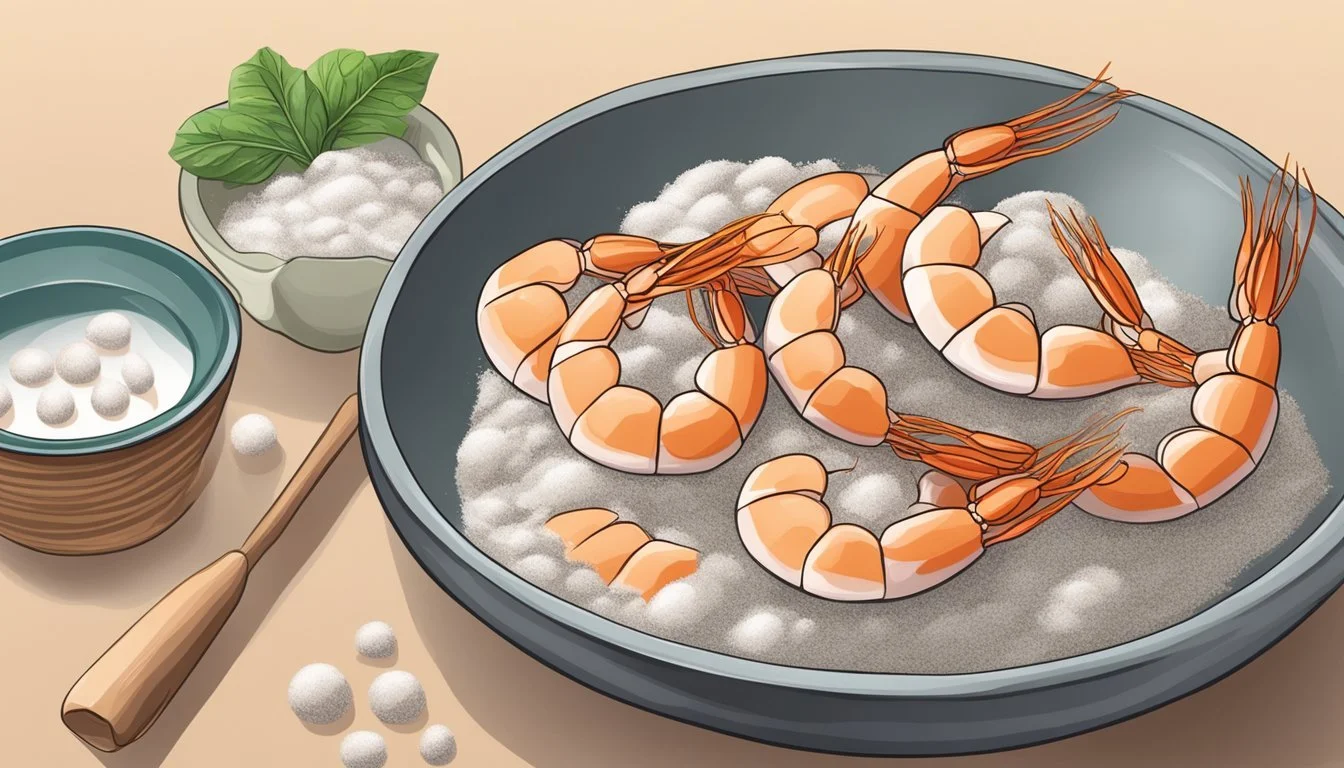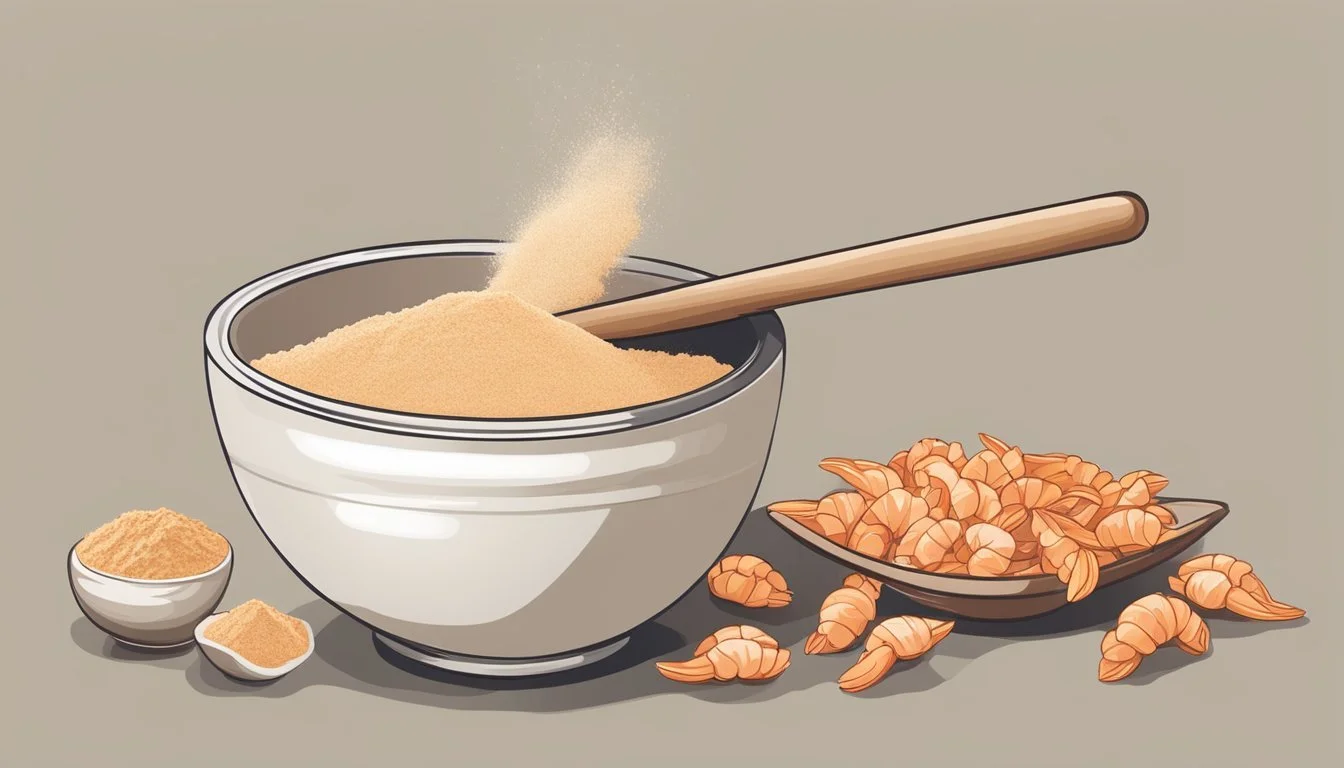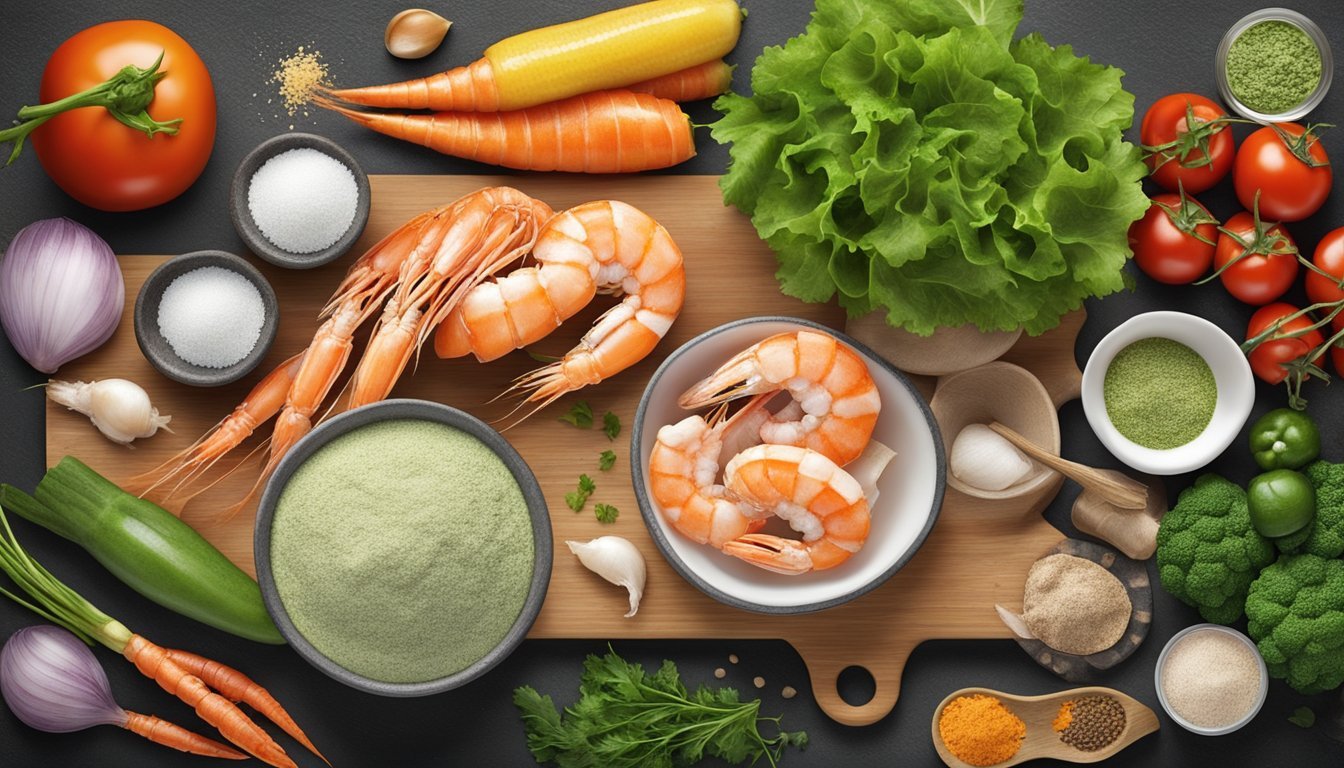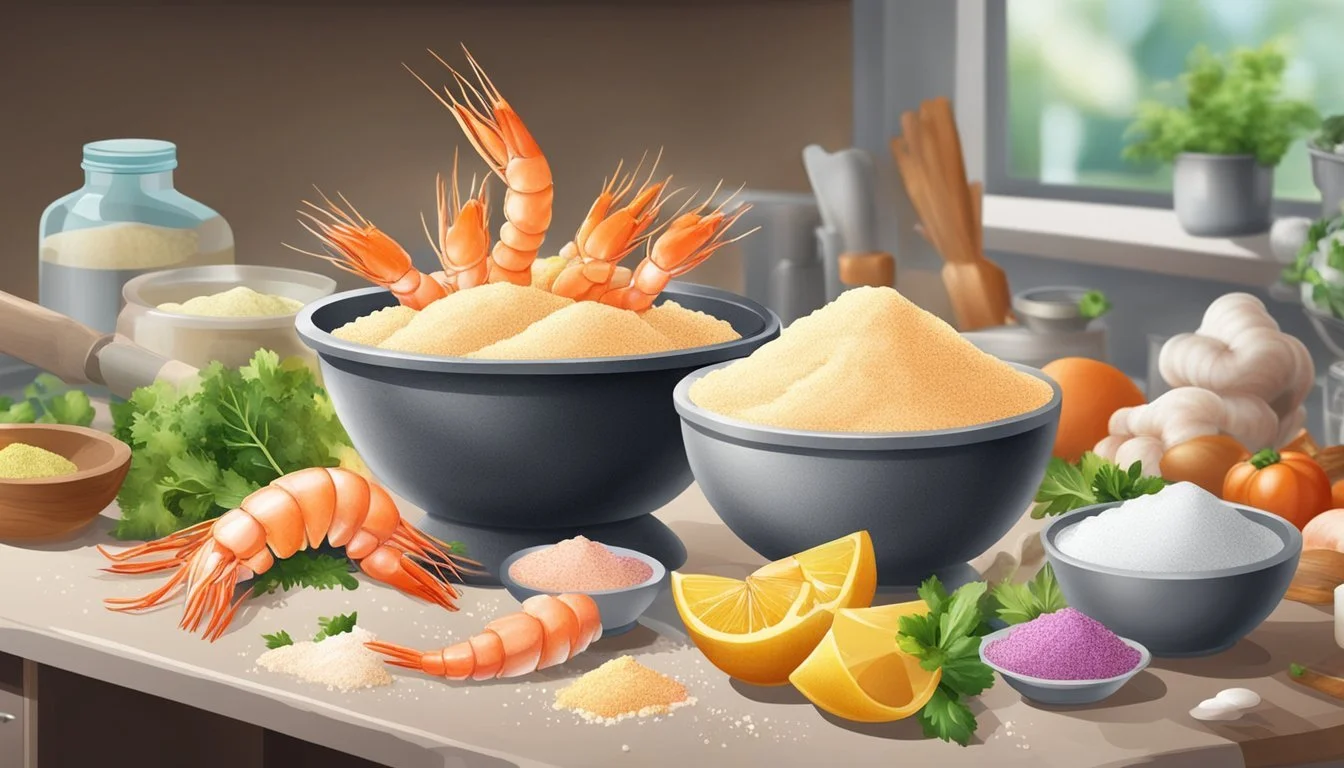How to Make Nutrient-Dense Shrimp Shell Powder
A Guide for Enhanced Cooking Nutrition
Shrimp, (What wine goes well with shrimp?) a popular seafood (What wine goes well with seafood?) enjoyed by many, isn't just prized for its delicate flavor and texture but also for its impressive nutritional profile. High in protein and a source of essential minerals, shrimp offers a lean protein option for those looking to enrich their diet. It is in the shells, often discarded as waste, where a treasure trove of flavor and nutrients resides. Shrimp shells contain valuable components that, when transformed into a fine powder, can be utilized to enhance both the flavor and nutritional density of various dishes.
Creating shrimp shell powder is a sustainable cooking practice that extracts maximum benefit from the crustacean. The shells are rich in chitin, a fiber that can offer health benefits, including supporting joint health and reducing inflammation. When shrimp shells are dried and ground into a fine powder, they can easily be integrated into recipes, offering an additional layer of umami essence to meals while tapping into the macro- and micronutrients present in the shells.
By using shrimp shell powder in cooking, one not only prevents waste but also infuses meals with an extra dose of nutrients. This practice speaks to the resourcefulness of cooks who strive to use every part of their ingredients. Adding shrimp shell powder to one's culinary arsenal aligns with the principles of a sustainable and health-conscious kitchen, elevating the nutritional value of everyday cooking without compromising on taste.
Benefits of Shrimp Shells
Shrimp shells are often discarded, yet they are a treasure trove of nutrients that can enhance both the flavor and nutritional profile of various dishes.
Nutritional Components
Shrimp shells contain a variety of nutrients that are beneficial to health. When dried and ground into powder, these shells provide:
Protein: Essential for muscle repair and growth.
Fiber: Aids in digestion and may help regulate blood sugar levels.
Minerals:
Vitamins:
Vitamin A: Necessary for vision and the immune system.
Vitamin B12: Critical for nerve function and blood cell formation.
Niacin (Vitamin B3): Supports metabolism and skin health.
Additionally, shrimp shells are a source of astaxanthin, a powerful antioxidant that gives shrimp their pink color and offers anti-inflammatory benefits.
Health Advantages
Incorporating shrimp shell powder into one's diet can lead to several health advantages. The high concentration of astaxanthin plays a role in reducing inflammation and may have implications for improved joint and skin health. The presence of selenium and zinc contributes to a robust immune system.
Shrimp shell powder is also low in saturated fat and cholesterol, making it a heart-healthy addition to meals. The nutrients in shrimp shells, like omega-3 fatty acids, may aid in balancing cholesterol levels by increasing HDL (good cholesterol) and decreasing LDL (bad cholesterol).
Thus, utilizing shrimp shells not only minimizes food waste but also provides significant nutritional benefits.
Preparing Shrimp for Shell Powder
To create a highly nutritious shrimp shell powder, one begins with careful selection and meticulous preparation of the shrimp. Ensuring the shrimp are clean and free of any unwanted parts is critical for a pure and flavorful powder.
Selecting Quality Shrimp
When sourcing shrimp for shell powder, prioritize freshness and quality. One must look for:
Brightness: Shells should be shiny and vibrant.
Firmness: Shrimp should feel firm and springy to the touch.
Smell: Fresh shrimp have a mild, briny scent, not overpowering or unpleasant.
A simple table can summarize the aspects to examine:
Quality Aspect What to Look For Color Bright, translucent shells without any blemishes. Texture Shells that are firm, indicating freshness. Odor Mild, sea-like aroma, free from any ammonia-like smells.
Peeling and Deveining Shrimp
Peeling and deveining raw shrimp is the next step before creating powder. Here are the steps to ensure the shrimp is properly prepared:
Rinse: Wash the shrimp under cold water to remove any surface dirt or grit.
Peeling: Grasp the shrimp by the legs and gently pull the shell away from the body. For shell powder, retain the shell and set the peeled shrimp aside for other uses.
Deveining: Make a shallow cut down the back of the shrimp to expose the dark vein, then remove it using the tip of a knife or a deveining tool.
By peeling and deveining, one removes the parts not desired in the powder, such as the digestive tract, leaving only the valuable shell, which is rich in nutrients like calcium and chitin.
Drying and Grinding Process
To create shrimp shell powder, one must thoroughly dry the shells and then grind them to the appropriate texture. This process ensures the powder's nutrient density and usability in cooking.
Drying Shrimp Shells
The first step is dehydrating the shrimp shells to remove all moisture. This is crucial to avoid spoilage and to make the grinding process more effective.
Oven Method:
Preheat the oven to its lowest setting, typically between 150°F (65°C) to 200°F (93°C).
Spread the shrimp shells on a baking sheet, ensuring they are not overlapping.
Place the tray in the oven for approximately 1 to 2 hours.
Check periodically to ensure they are drying without burning.
Grinding into Powder
Once the shrimp shells are completely dry, the next step is to grind them into a fine powder.
Using a Grinder or Food Processor:
Transfer the dried shells to a grinder or food processor.
Pulse several times until the desired texture is achieved; a fine, consistently granulated powder for most culinary applications.
For extra fine powder, sift through a fine-mesh strainer or sieve, returning larger pieces to the grinder.
Texture: Aim for a homogeneous powder that blends seamlessly into dishes without altering the desired consistency.
Incorporating Shrimp Shell Powder in Recipes
Shrimp shell powder is an underutilized ingredient that can add depth of flavor and a burst of nutrition to various dishes. Here's how to integrate this powerhouse additive into everyday cooking.
Seasoning Mixes and Spices
One can infuse shrimp shell powder into seasoning blends to elevate the flavor profile of a dish. For example, blending it with Old Bay seasoning could complement traditional seafood recipes. When creating a homemade seasoning mix, one might start with a base of garlic powder, onion powder, and paprika, then add a teaspoon of shrimp shell powder to impart a subtle, seafood essence.
Recipe Suggestion: Incorporate into a seasoning for grilling seafood or poultry.
Salad Tip: Sprinkle over a fresh salad for a hint of umami.
Enhancing Soups and Broths
In soups and broths, shrimp shell powder acts as a natural flavor enhancer. Its rich, marine taste deepens the base of broths without overpowering the other ingredients.
Soup Enhancement: Stirring in a tablespoon of the powder could transform a simple vegetable soup into a savory delight.
Broth Preparation: When preparing homemade broth, blend in the powder during the initial stages of boiling to infuse the liquid with nutrients and complex flavors.
Thickening Agent for Sauces
Apart from its flavor profile, shrimp shell powder also serves as an efficient thickening agent for sauces due to its fine consistency and ability to blend seamlessly.
Sauce Application: A small amount mixed into bechamel or a seafood sauce can not only thicken but also enhance the sauce's flavor dimensions.
Recipe Incorporation: Utilize in recipes where a subtle seafood taste is desired without the addition of actual shellfish. (What wine goes well with shellfish?)
By integrating shrimp shell powder into these culinary applications, chefs and home cooks alike can boost the nutritional value and taste dynamics of their favorite dishes.
Creative Cooking Ideas with Shrimp Shell Powder
Shrimp shell powder is a versatile ingredient that can add a nutrient boost and a burst of flavor to various dishes. From grains to marinades, its umami-rich profile enhances meals with a taste of the sea.
Shrimp Flavored Rice and Pasta
One can incorporate shrimp shell powder into rice or pasta dishes to enrich them with a subtle seafood flavor. For Rice, simply sprinkle a teaspoon of shrimp shell powder into the cooking water for an aromatic infusion. When preparing Pasta, one can blend the powder with herbs, mixing it into the sauce for a robust flavor profile.
Recipe Suggestion:
Ingredients:
1 tsp shrimp shell powder
1 cup rice or pasta
Herbs of choice (e.g., parsley, basil)
Directions:
Add shrimp shell powder to boiling water.
Cook rice or pasta as usual.
Toss with herbs before serving.
Marinades and Rubs for Seafood
Shrimp shell powder serves as an excellent addition to seafood marinades and rubs. For Marinades, mix the powder with olive oil, lemon juice, and garlic to marinate fish before cooking. As a Rub, combine the powder with salt, pepper, and other spices to coat items such as salmon or shrimp before grilling or roasting.
Marinade Recipe:
Ingredients:
1 tbsp shrimp shell powder
2 tbsp olive oil
Juice of 1 lemon
1 garlic clove, minced
Instructions:
Whisk all ingredients together.
Marinate seafood for at least 30 minutes.
Baked Goods and Breading
Incorporate shrimp shell powder into the breading for fried seafood or even chicken for an extra dimension of flavor. Use it in Bread recipes where its nutritional benefits and taste can complement the ingredients, such as in homemade fish sticks or crouton recipes.
Breading Mix:
Ingredients:
2 tbsp shrimp shell powder
1 cup breadcrumbs
1 tsp paprika
Salt and pepper to taste
Method:
Combine all dry ingredients evenly.
Use to coat seafood or chicken before frying.
Nutrient-Dense Meal Prep with Shrimp Powder
Shrimp powder adds a burst of flavor and nutrition to meal preps. Crafted from ground shrimp shells, it is rich in calcium and chitin, which can support joint health and may contribute to a reduction in inflammation. Meal prepping with shrimp powder not only infuses dishes with a savory seafood essence but also enhances their nutritional profile, making them an excellent addition to a variety of recipes.
Quick and Easy Shrimp Tacos
For a speedy meal prep, Cajun Shrimp Tacos are an exceptional choice. Season the shrimp with shrimp powder, smoked paprika, and a Cajun spice blend for a robust flavor. Cook quickly in a skillet and serve in jicama shells to keep it low-carb. Top with a cilantro lime shrimp garnish for an additional burst of zest.
Ingredients:
Shrimp, seasoned with shrimp powder and Cajun spices
Jicama shells
Cilantro for garnish
Healthy Shrimp Salad Variations
Shrimp salad can be tailored to various dietary needs, including keto and paleo. Utilize shrimp powder to season the shrimp, then toss with greens and vegetables of choice. For a grain inclusion, quinoa can serve as a nutritious base, while zucchini noodles offer a low-calorie and gluten-free alternative.
Salad Bases:
Traditional: Mixed greens
Keto: Spinach and avocado
Paleo: Arugula and roasted sweet potatoes
Quinoa: For a protein-packed grain option
Zucchini (What wine goes well with zucchini?) Noodles: For a lighter, low-calorie salad
Shrimp Scampi and Pasta Alternatives
Shrimp scampi (What wine goes well with shrimp scampi?), typically rich and indulgent, can be transformed into a healthier meal prep ingredient through shrimp powder. Instead of using pasta, opt for zucchini noodles or spaghetti squash as a base, aligning with keto and paleo dietary preferences. The shrimp can be lightly sautéed with garlic, lemon, and a hint of shrimp powder for a simple yet flavorful meal.
Pasta Alternatives:
Zucchini Noodles
Spaghetti Squash
Incorporating shrimp powder into meal prep recipes ensures that dishes are not only delicious but also nutrient-dense. By using it in shrimp tacos, salads, and scampi alternatives, one can enjoy the health benefits of a seafood diet in a convenient and varied meal plan.
Storage and Shelf Life
Proper storage of shrimp shell powder is crucial to maintaining its nutrient density and flavor. Knowing how to store the powder effectively can ensure it keeps its quality over an extended period.
Proper Container Use
One should store shrimp shell powder in airtight containers to prevent exposure to moisture and air, which can deteriorate the powder’s quality. Glass jars with a tight seal are ideal, as they do not retain odors or flavors that could transfer to the powder.
Material: Glass or food-grade plastic
Seal: Tight-fitting lid
Bags with sealable tops are a suitable alternative for short-term storage but may not provide as robust a barrier against humidity and odors as containers with more secure sealing mechanisms.
Ideal Conditions for Long-Term Storage
Shrimp shell powder benefits from storage in a cool, dry place away from direct sunlight, which can preserve its shelf life. Warmer temperatures and sunlight can cause the powder to degrade more quickly, leading to a loss of flavor and nutrients.
Temperature: Below 75°F (24°C)
Light Exposure: Minimal
Humidity: Under 50%
By regulating temperature and humidity, one ensures optimal preservation of the shrimp shell powder's quality. It should be noted that even under ideal conditions, the shelf life typically ranges from 6 months to 1 year. Regularly checking the powder's aroma and color can help one gauge its freshness over time.
Safety and Dietary Considerations
When incorporating shrimp shell powder into a diet, individuals should consider potential allergies and the balance of dietary fats in the product. These factors are crucial for maintaining a safe and healthy dietary practice.
Allergies and Intolerances
Shrimp is a common allergen, and individuals with shellfish allergies should avoid shrimp shells entirely, including powder made from them. Shrimp shell powder is gluten-free by nature, making it suitable for those with gluten intolerance or celiac disease.
Balancing Dietary Fats
Shrimp shells contain cholesterol, which can be a concern for individuals monitoring their cholesterol intake. However, dietary cholesterol's impact on blood cholesterol is complex and varies between individuals. One should balance shrimp shell powder consumption within the larger context of their diet, considering both polyunsaturated and monounsaturated fats. A diet with a variety of these fats, found in foods like fish, nuts, and seeds, can support cardiovascular health.







